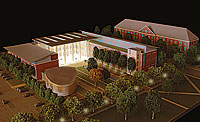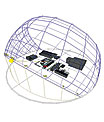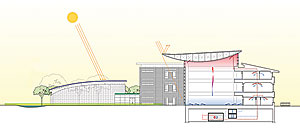Selling the Light of Day
Dave Ginley, an NREL researcher, focuses on organic PV cells, which don't integrate silicon-a material with a finite production supply-in their production. While Ginley finds organics' infinite supply appealing, he thinks their true promise is the flexibility of their application. The bond structure of a conventional silicon molecule is a predictable crystalline structure, whereas organic molecules have a "hair" chain sprouting along the sides of their double-bonds. This hair can be tinkered with, in a way that adds or removes electrons, to develop a molecule with the exact properties you want. "This isn't to say we know what those exact properties are," Ginley says. "If we did, we'd be done, and we're not."
Organic PVs, though at least 10 years away from commercial application, offer the possibility of design considerations such as fabric structures and basically any surface that can withstand a printing process. Organic PVs also have the potential to lower costs, since a single metric ton of a petrochemical could supply all of the organic solar cells you would ever want to make. Where the thickness of silicon-based cells are measured in micrometers, organic PVs can be reduced to a few hundred nanometers, similar in production and use as plastics.
Bernard Kippelen, a researcher at the Georgia Institute of Technology and a partner in a related start-up company, Lumoflex, considers organic PV materials akin to an ink, capable of printing on any surface. "Because they are thin, absorb light fairly efficiently, and can be processed at room temperature, you can envision solar cells with fairly interesting form factors in terms of application," Kippelen says. Among the major obstacles organics must overcome, degradation ranks high. Kippelen says printing organic PVs onto any surface could potentially shorten the PV's lifespan, which is why he suggests the short-term use of organic PVs will be confined to small devices, like RFID tags or personal electronics. Eventually, this market could grow to include portable tents or large-scale fabric structures.
Among the remaining challenges for organic PV researchers, hastening higher efficiencies is key to the technology's success. Currently, efficiency hovers between 5 and 6 percent, while organic PV's theoretical efficiency of 24 percent competes directly with silicon.
NREL's Ginley thinks the greatest potential for organics lies in the organic LED (OLED) industry, which could easily adapt itself to become a producer of organic PV products. "The ultimate would be OLEDS and solar cells where you could have a skylight that would make power by day and then at night make light," he says. Another advanced organic PV development has been spray-on technology, where PV cells are incorporated into a liquid that could be applied to a building surface. While the lifespan is short, Joop Schnoonman, director of the Delft Centre for Sustainable Energy in the Netherlands, has developed an aerosol spray-on PV cell using a mix of copper indium sulfide and titanium dioxide that has led to a longer lifespan and an approximate 5 percent efficiency. "We are trying to make a cheap production technology with cheap materials," Schnoonman says, adding, "Any shape of surface could be sprayed." Solar industry researchers and manufacturers view the flexible application of PVs to buildings as key to achieving widespread use in architecture.












